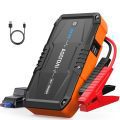In this step-by-step guide on “How to Choose the Right Car Power Inverter,” you’ll discover essential insights that can transform your travel experience, allowing you to power your devices no matter where the road takes you. Did you know that a car’s battery can provide enough energy to power a small house for an entire day? This shocking fact highlights the importance of understanding your inverter’s capacity and compatibility with your devices. The guide walks you through critical considerations such as wattage requirements, types of inverters, safety features, and portability, ensuring you make a well-informed choice that caters to your unique power needs. With the right inverter, you’ll never have to worry about your devices running out of juice during your adventures again!

![400W Power Inverter, FSATBTNE DC 12V to 110V AC Car Plug Adapter Outlet Converter with [65W PD USB-C] & [18W QC USB-A] Fast Charging Ports and 2 AC Outlets Car Power Inverters for Vehicles](https://m.media-amazon.com/images/I/41GUdr-xNNL._SS520_.jpg)

Determine Your Power Needs
List all the electronics you plan to use with the inverter. Include items such as laptops, smartphones, televisions, and kitchen appliances. Find the wattage ratings for each device, which can usually be found on the device itself or in the user manual. For example, a laptop may require around 60 watts, while a small refrigerator could need about 200 watts.
Add up the wattage of all devices you intend to run simultaneously. This total will give you the minimum power output required from your inverter. If you plan to use multiple devices at once, ensure you factor in the cumulative wattage to avoid overloading the inverter. Always round up to the nearest inverter rating available to provide a buffer for power surges when devices start up.


Choose the Inverter Type
Evaluate your power needs carefully. Consider the devices you intend to use with the inverter. Choose a modified sine wave inverter if you require a cost-effective solution for simple electronics, but be aware that it may not support sensitive devices like computers or medical equipment. Opt for a pure sine wave inverter for a higher-quality power output that is compatible with all types of electronics, ensuring smoother operation and preventing potential damage, even though it comes at a higher price point.
Check the Inverter’s Input Voltage
- Verify the inverter’s specifications to determine its required input voltage, which is typically either 12V or 24V.
- Check your vehicle’s battery voltage using a multimeter or by consulting your vehicle’s manual to confirm the voltage level.
- Compare the inverter’s input voltage rating with your vehicle’s battery voltage to ensure they match.
- Ensure proper connections are made; mismatched voltages can lead to inefficiencies or damage the inverter.
Evaluate the Inverter’s Output Ports
Evaluate the number and type of output ports on the inverter. Check for multiple AC outlets, which can allow you to power several devices at once, such as a laptop and a small refrigerator. Identify if there are USB ports, ideal for charging smartphones and tablets quickly. Look for DC outputs as well, which can be used for connecting devices like LED lights or car batteries.
Consider the Inverter’s Size and Portability
Evaluate the locations where you intend to use the inverter, such as your vehicle, campsite, or home. Measure the available space in your vehicle to ensure a proper fit. Select a model that is both compact and lightweight, making it easy to transport. Prioritize power output, ensuring that the inverter meets your energy needs without compromising on portability.
Assess Safety Features
Examine the specifications of inverters for built-in safety features. Identify overload protection, which prevents the inverter from exceeding its capacity and causing damage. Check for short circuit protection, ensuring the device shuts down in case of a fault, safeguarding connected equipment. Look for thermal shutdown capabilities, which automatically turn off the inverter when it overheats, preventing potential hazards.
Check Reviews and Recommendations
Research customer reviews on various inverter models by visiting reputable retail websites and forums. Look for patterns in the feedback regarding reliability, performance, and customer satisfaction. Gather insights from expert recommendations by checking technology review sites and comparison articles. Analyze the pros and cons highlighted by both customers and experts to understand which models consistently receive high ratings and why.
Compare Prices and Warranty Options
Research various retailers online and in-store to gather a comprehensive list of prices for the item you wish to purchase. Use price comparison websites or apps to streamline this process and ensure you are getting the best deal. Evaluate warranty options offered by different sellers, focusing on the coverage terms, duration, and any additional costs associated with the warranty. Prioritize options that cover potential issues and repairs, as this provides added security and peace of mind for your investment.
Final Considerations for Selection
In conclusion, selecting the right car power inverter is crucial for ensuring your devices are powered effectively while on the road. By assessing your specific power needs, choosing the right type of inverter, and considering key features like size, safety, and output ports, you can make an informed decision. With the right inverter, you’ll not only enhance your travel experience but also ensure that you stay connected and powered up wherever your journey takes you.
Essential Equipment List
- Calculator
- Multimeter
- Measuring tape
- Power tools (if installation required)
- Extension cords
- Surge protector
- Inverter user manual
- Flashlight (for checking hard-to-reach areas)
- Safety goggles
- Gloves

Essential Insights
- Determine Your Power Needs: Calculate the wattage of the devices you plan to use to ensure the inverter can handle the load
- Choose the Right Type: Decide between a pure sine wave inverter for sensitive electronics or a modified sine wave inverter for simpler devices
- Check the Inverter’s Output: Look for an inverter with sufficient AC outlets and USB ports for your charging needs
- Consider Portability: If you plan to move the inverter frequently, choose a lightweight and compact model
- Evaluate the Input Voltage: Ensure the inverter is compatible with your vehicle’s power system, usually 12V for cars
- Look for Safety Features: Choose inverters with built-in protections like overload, short circuit, and overheat protection
- Read Reviews and Ratings: Research products for reliability and performance by checking customer reviews and expert ratings
- Check the Brand Reputation: Opt for trusted brands known for their quality and customer service
- Examine the Warranty: A longer warranty period can indicate a manufacturer’s confidence in their product
- Consider Installation Requirements: Determine if you need a portable inverter or a hardwired option, based on your usage and installation capabilities
Maximizing Your Car Power Inverter: Tips for Safe and Efficient Use
- Select the Right Inverter: Choose an inverter that matches your power needs. Consider the total wattage of the devices you plan to use and ensure the inverter can handle that load. A common choice for small electronics is a 300-500 watt inverter
- Connect to Your Vehicle: Plug the inverter into your car’s 12V power outlet (also known as the cigarette lighter). For higher wattage inverters, you may need to connect directly to the car battery using alligator clips
- Power Up Devices: Once connected, turn on the inverter. You can now plug in your devices, such as smartphones, laptops, or small appliances, into the inverter’s AC outlets. Make sure not to exceed the inverter’s wattage limit
- Monitor Usage: Keep an eye on the inverter’s indicator lights or display (if available) to ensure it’s operating correctly. Avoid using it for extended periods with the engine off, as this can drain the car battery
- Turn Off When Not in Use: To conserve power and prevent unnecessary drain on the vehicle’s battery, turn off the inverter when you’re done using it. Unplug it from the power outlet if you won’t be using it for a while
- Following these steps will help you safely and effectively use a car power inverter to power your devices on the go!
Essential Insights on Car Power Inverters
Can a car power inverter charge multiple devices at once?
Yes, a car power inverter can charge multiple devices at once, provided it has the appropriate number of outlets and sufficient wattage capacity. Most inverters come with multiple AC outlets and USB ports, allowing you to charge several devices simultaneously. However, it’s important to ensure that the total wattage of all connected devices does not exceed the inverter’s rated capacity, as this could lead to overheating or damage to the inverter. Always check the specifications of the inverter and the power requirements of your devices to ensure safe and efficient operation.
How do I maintain and care for my car power inverter to ensure its longevity?
Maintaining and caring for your car power inverter is essential for ensuring its longevity and optimal performance. Here are some key steps to follow:
- Keep it Clean: Regularly inspect your inverter for dust and debris. Use a soft cloth to wipe it down, ensuring that ventilation slots are free from obstructions. Overheating can be a common issue if air cannot circulate properly.
- Check Connections: Ensure that all connections are tight and free from corrosion. Loose or corroded terminals can lead to poor performance or even damage. If necessary, clean the terminals with a wire brush and apply a protective coating to prevent future corrosion.
- Monitor Temperature: Power inverters can generate heat during operation. Avoid placing the inverter in enclosed spaces or near heat sources. If it has a built-in fan, make sure it’s functioning properly, and consider operating the inverter in cooler conditions when possible.
- Avoid Overloading: Be mindful of the wattage limits of your inverter. Overloading it by connecting devices that exceed its capacity can cause overheating or permanent damage. Always check the specifications before plugging in new devices.
- Use Proper Cables: Use high-quality, appropriately rated cables for your inverter. Inferior or incorrect wiring can lead to voltage drops, overheating, or electrical fires.
- Disconnect When Not in Use: To avoid battery drain, disconnect the inverter from the battery when it’s not in use. This can also prevent potential damage from power surges or electrical issues.
- Regularly Test the Inverter: Periodically test the inverter with devices to ensure it is functioning correctly. This can help catch any issues early before they become serious problems.
- Consult the Manual: Always refer to the manufacturer’s manual for specific maintenance guidelines and recommendations. Different models may have unique care requirements.
By following these steps, you can help ensure that your car power inverter remains in good working condition and lasts for many years.
Are there any specific brands known for high-quality car power inverters?
Yes, there are several brands known for producing high-quality car power inverters. Some of the most reputable brands include:
- Bestek – Known for its reliable performance and multiple outlet options, Bestek offers a variety of power inverters suitable for different needs.
- Energizer – This brand provides a range of inverters with good power output and safety features, making them a popular choice among consumers.
- Ampeak – Ampeak inverters are recognized for their affordability and effective performance, catering to both casual users and those needing more robust power solutions.
- Krieger – Offering a range of high-capacity inverters, Krieger is known for its durability and advanced features, including built-in protections.
- Xantrex – Xantrex specializes in higher-end power inverters, often used in RVs and marine applications, providing excellent reliability and performance.
When selecting a power inverter, it’s essential to consider the specific power needs, compatibility with your devices, and safety features to ensure optimal performance.







I use the Energizer 400W inverter and it works wonders for camping trips. I can power everything from my phone charger to a small TV! Just a heads up, always check the power ratings of your devices before plugging them in. Anyone else have favorite inverters for camping?
Great guide! I’d love to see a follow-up article on how to install a car power inverter. Are there common mistakes to avoid?
Thanks for your suggestion! Installing a car power inverter can definitely come with its own challenges. We’ll consider writing an article on that soon!
A solid tip: make sure to use high-quality cables when connecting your inverter to avoid overheating and ensure efficient power transfer. Also, consider getting a pure sine wave inverter if you plan to power sensitive electronics like laptops. It makes a huge difference!
Great advice! Using quality cables is crucial for safety and performance. Thanks for sharing your tip about pure sine wave inverters too! They’re definitely a better choice for sensitive devices.
What are some advanced tips for choosing an inverter for heavy-duty appliances? Like, can I run a microwave with a car inverter?
I noticed that some inverters have built-in USB ports. Are these as reliable as regular outlets? Would love to hear thoughts on that!
I recently bought the BESTEK 300W Power Inverter for a road trip, and it was a game changer! I was able to charge my laptop and run a small fridge without any issues. Highly recommend it for anyone looking for reliable power on the go! Anyone else had similar experiences? Would love to hear more!
I feel like the safety features section could use more detail. What specific features should we look for to ensure we’re not risking our devices?